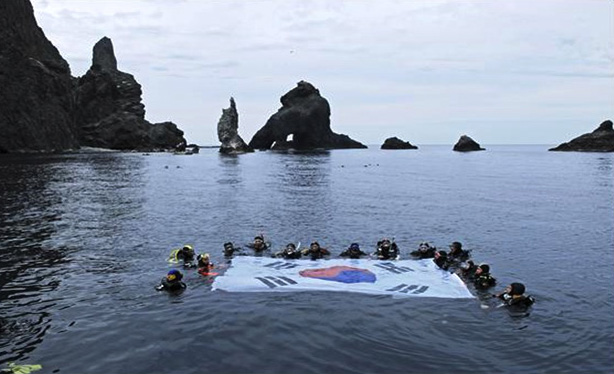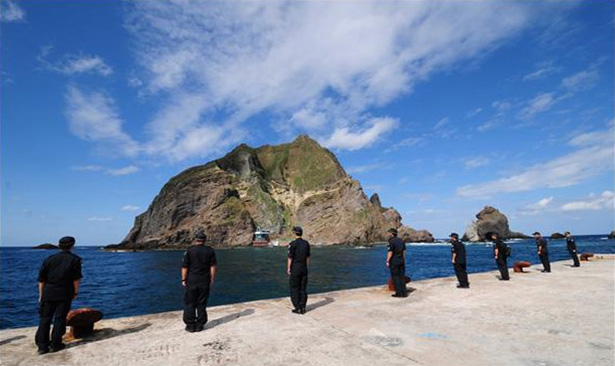
Dokdo Island, which is located in the far east of Korea, is the first place of sunrise in Korea and comprises of East Island (Dongdo) and West Island (Seodo) as well as 89 annexed islands. The total surface area including the East Island, West Island, and annexed islands amount to 187,554 m2. Although the West Island has higher sea level and greater surface area, various facilities have been built on the East Island where the slope is less steep.
Dokdo Island is located 87.4 km to the southeast of Ulleungdo Island, which is the closest island. The closest mainland is Jukbyeon, Uljin-gun, in North Gyeongsang Province, with a lineal distance of 216.8 km. Meanwhile, the closest Japanese territory from Dokdo Island is Oki Island in Shimane, located further than Ulleungdo Island at 157.7 km. On a clear day, Ulleungdo Island can be seen with bare eyes from Dokdo Island but Oki Island is out of sight at all times. Due to these geographical characteristics, Dokdo Island has historically been identified as part of Ulleungdo Island.
Dokdo’s geographical location has become even more important given the increasing significance of the role and the status of the seas. At the same time, it is being considered with weight from militaristic and national security perspective to neighboring countries including Japan and Russia. Waters surrounding Dokdo is home to diverse marine life and a rich fishery. Moreover, it is significant from the economic perspective as there is a large amount of next generation energy resources such as methane hydrate reserved nearby. In particular, there is a growing interest as regions with methane hydrate are known to be highly correlated with existence of oil reserves.

Dokdo Island is a volcanic island that was formed sometime between 2.5 million to 4.6 million years ago by lava that erupted from 2,000m underwater. Although it cannot be seen, a very large seamount supports Dokdo Island beneath the sea. While the top of East Island is relatively flat, that of West Island forms a sharp cone. The coastline is mostly made up of sea cliffs and is several faces of the rocks, there are taffonis that look like hives. Because there is a channel of underground water in the northern coast of West Island, 400 liters of fresh water become available every day. The channel was used as the source of drinking water until desalination facility was installed on Dokdo Island.
Dokdo Island, which is affected by warm current, shows typical ocean climate like Ulleungdo Island. Annual average temperature is 12 degrees Celsius with a relatively warm average temperature in January at 1 degree Celsius. The annual average wind speed is 4.3m/s, with southwester superior in summer and northeaster in winter. Because there is a lot of fog, more than 160 days are cloudy in a year. The annual average precipitation is 1,240 mm and is categorized as a heavy snowfall region in winter along with Ulleungdo Island.
※ Seamount: As land formed by underwater volcanic activity, it refers to mountains underwater that are higher than 1,000m from the ocean floor.
It is underwater, steep, and isolated.
※ Tiffoni: Area formed from prolonged weathering with small and large holes on the surface of rocks due to chemical or physical effects.
Animals and plants that have breathed life on Korea’s Dokdo Island are mainly small flowers, trees, birds, and insects. There are many plants on Dokdo Island that blossom small flowers throughout the year except in winter. Flowers representing seasons of Dokdo Island are coastal rockcress (spring), coastal mosslike stonecrop and seashore oriental wormwood (summer), and aster (fall). Despite unfavorable conditions due to shallow soil, trees such as Ulleungdo honeysuckle, fortunes creeping spindle, camellia, and Japanese black pine grow on Dokdo Island. Plants and trees provide habitat for birds and insects. On Dokdo, there are not only resident birds but also many migratory and passage migrant birds that stop by. Dokdo is a breeding ground for black-tailed gulls and fork-tailed petrels and also houses natural monuments such as hawks, Korean buzzards, and wood pigeons. Insects like Hymneia recurvalis, Java drone flies, and painted lady butterflies are small lives that can be spotted on Dokdo. In particular, as it plays the role of geographical boundary for many insects and living resources, Dokdo is extremely important biologically.
Dokdo became Korea’s territory when Governor Isabu of Haseulla (Gangneung) incorporated Usanguk into the Silla Kingdom in 512AD during the 13th year of King Jijeung’s reign. Documents from the Joseon Dynasty also record Dokdo as its territory. For example, in King Sejong’s Treatise on Geography (1454), it clearly states Ulleungdo and Dokdo as its own by recording that “Usan (Dokdo) and Mureung (Ulleungdo) are located to the east of Uljin. Because the two islands are not far from each other, one can see the other island on clear days.” In 1693, during the 19th year of Sukjong’s reign, Ahn Yong-bok went to Japan after spotting Japanese fishermen near Ulleungdo and Dokdo, and received an official recognition of Tokugawa Shogunate that Ulleungdo and Dokdo belonged to Korea.
The Meiji government of Japan also affirmed that Ulleungdo and Dokdo had no relevance to Japan in 1877. In March of the same year, Dajokan, Japan’s highest decision-making organ, ordered Japanese Naimusho (Ministry of Home Affairs) to not include Ulleungdo and Ildo (Dokdo) as its land as they are irrelevant to Japan.” Meanwhile, the Great Han Empire clearly stated that Ulleundo and Dokdo were its territory by placing Seokdo (Dokdo) under the jurisdiction of Uldo (Ulleungdo) through Edict No. 41 in 1900 during the 4th year of Gwangmu.
Nevertheless, having recognized the strategic importance of East Sea and Dokdo during the Russo-Japanese War (1904-1905) on the East Sea, Japan’s Shimane Prefecture unilaterally incorporated Dokdo by issuing Notice No. 40. In 1945, following the defeat of Japan in the Second World War, Korea was liberated, and Dokdo was recognized as Korean territory by the international community through the 1943 Cairo Declaration and 1945 Potsdam Declaration. Furthermore, in 1946, the Supreme Command for Allied Powers issued SCAPIN No. 677, which explicitly shows that Ulleungdo and Dokdo are under the administrative jurisdiction of Korea. Dokdo, as Korea’s territory guarded by many patriots and martyrs over a long period of history, is a proud territory of Korea resided by our citizens and protected by Korean police and navy.

Since 1954, the Japanese government remained steadfast in the opinion to resolve the Dokdo dispute by filing a petition to the International Court of Justice. There is no need for Korea to respond to this move by Japan. There is no doubt that Dokdo Island is inherently Korea’s territory and cannot be a subject of legal resolution or diplomatic intervention. While responding firmly to Japan’s provocation, Korea needs to focus on creating an environment on Dokdo where Korean can live safely and happily through utilization, preservation, management of Dokdo and waters surrounding Dokdo, and protection of the ecosystem, in accordance with the laws on sustainable use of Dokdo Island.
Dokdo Residents
Jong-duk Choi (1925-1987) was the first resident of Dokdo Island. When Japan began to argue for territorial sovereignty over Dokdo in 1980, Choi moved his official address to Dokdo in 1981 in order to show that Dokdo is an inhibited island of Koreans. Today, there are 10 people and 9 households on Dokdo including a couple Sung-do Kim and Sinyeol Kim.
Address of Dokdo Island
Isabu-gil (East Island), Dokdo Anyongbok-gil (West Island), Ulleung-gun, Ulleung-eup, North Gyeongsang Province, Korea
Dokdo Coast Guard
Dokdo Coast Guard is affiliated with North Gyeongsang Police Agency and is in charge of safeguarding Korea’s Dokdo Island.

※ The texts were written based on the outcome of “development of marine territory educational and promotional data” project pursued by the Korea Maritime Foundation in 2013.